Abstract
To clarify the nature of the noradrenaline (NA)-induced contraction, the effects of NA on inositol phospholipid metabolism and the actions of inositol 1,4,5-trisphosphate (InsP3) on skinned muscle of the rabbit mesenteric artery were investigated. NA, in concentrations over 1 nM, reduced the amount of phosphatidylinositol 4,5-bisphosphate (PI-P2) and increased the amount of phosphatidic acid (PA). The maximum reduction in the amount of PI-P2 and the maximum increase in the amount of PA were observed in the presence of 1 microM-NA. With prolonged application of NA, the PI-P2 was gradually restored to near the control level, but with repeated applications of NA separated by rinses with Krebs solution, there was a consistent reduction of PI-P2. The NA-induced PI-P2 breakdown was inhibited by the alpha 1-adrenoceptor blocking agent, prazosin. After incubation of the tissue with radioactive inositol-containing solution, NA transiently increased the amount of radioactive InsP3 which was followed by increases in the amount of inositol 1,4-bisphosphate (InsP2) and inositol monophosphate (InsP). After accumulation of Ca by saponin-treated muscle cells of the dog mesenteric artery dispersed by collagenase, InsP3 released Ca stored in cells but InsP2 did not. A23187 (5 microM) but not InsP3 (up to 10 microM), depleted Ca accumulated in the presence of ATP. In saponin-treated skinned muscle tissues, InsP3 in concentrations over 0.3 microM, produced contraction following accumulation of Ca into the store site. InsP3 released Ca from the same source as caffeine. The release of Ca by InsP3 appeared in a concentration-dependent manner and this release also depended on the amount of Ca stored in cells (the median effective dose (ED50) was 3.0 microM in 0.1 microM-Ca and 1.0 microM in 0.3 microM-Ca). We concluded that NA activates alpha 1-adrenoceptors, thus hydrolysing PI-P2 and synthesizing InsP3. This product can release Ca stored in cells as estimated from the contraction in skinned muscle tissues, and also reduces the residual amount of Ca stored in skinned dispersed muscle cells. Contraction evoked by NA through pharmacomechanical coupling can be explained as a function of InsP3.
Full text
PDF
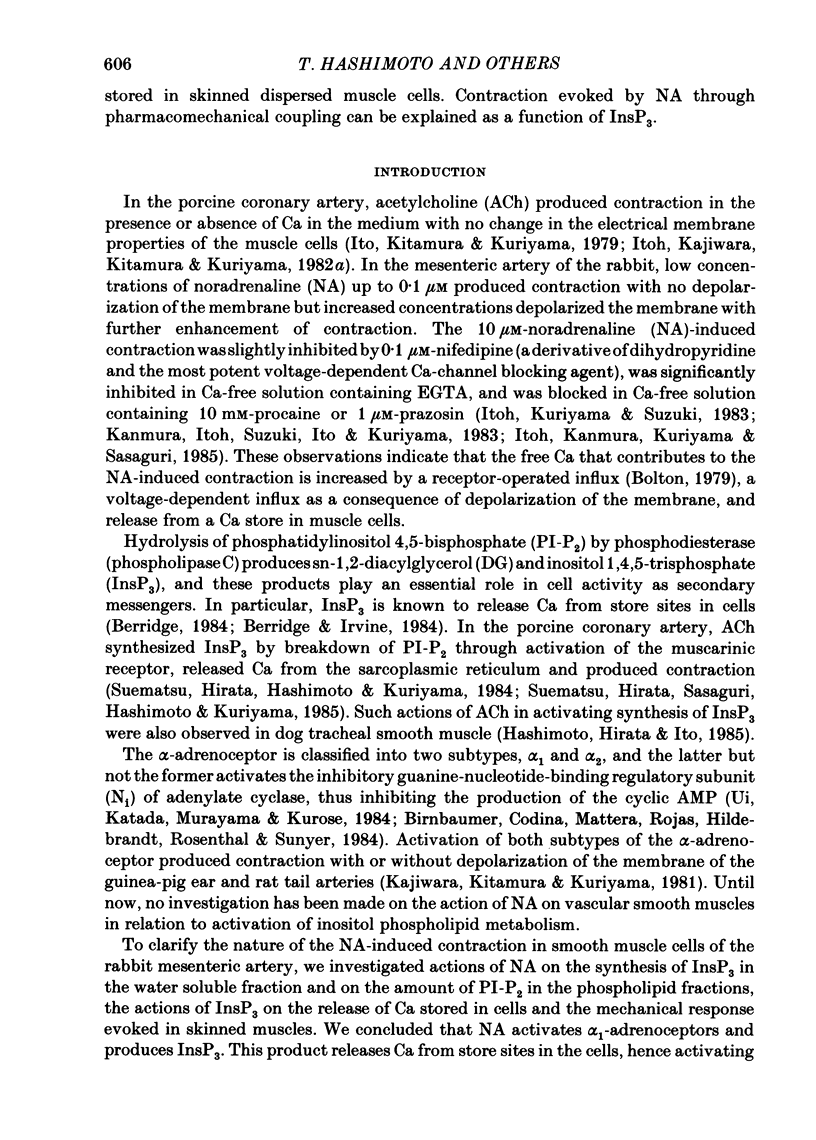

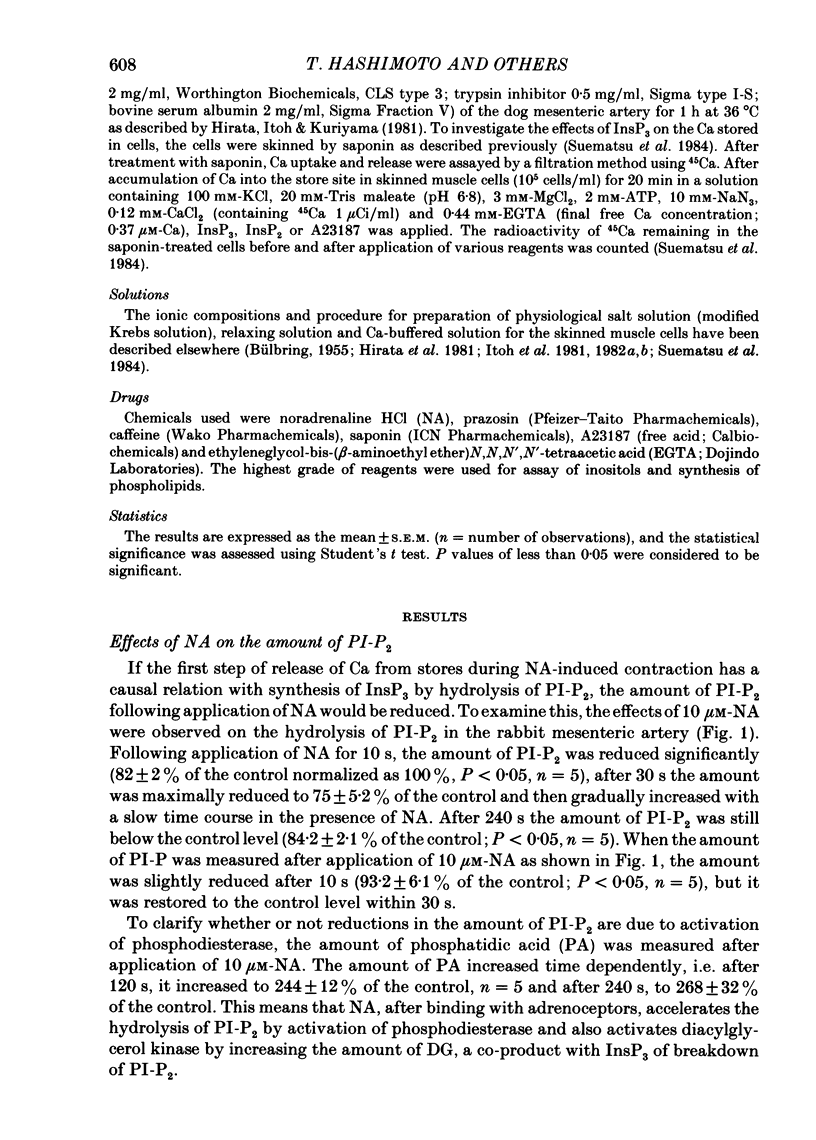


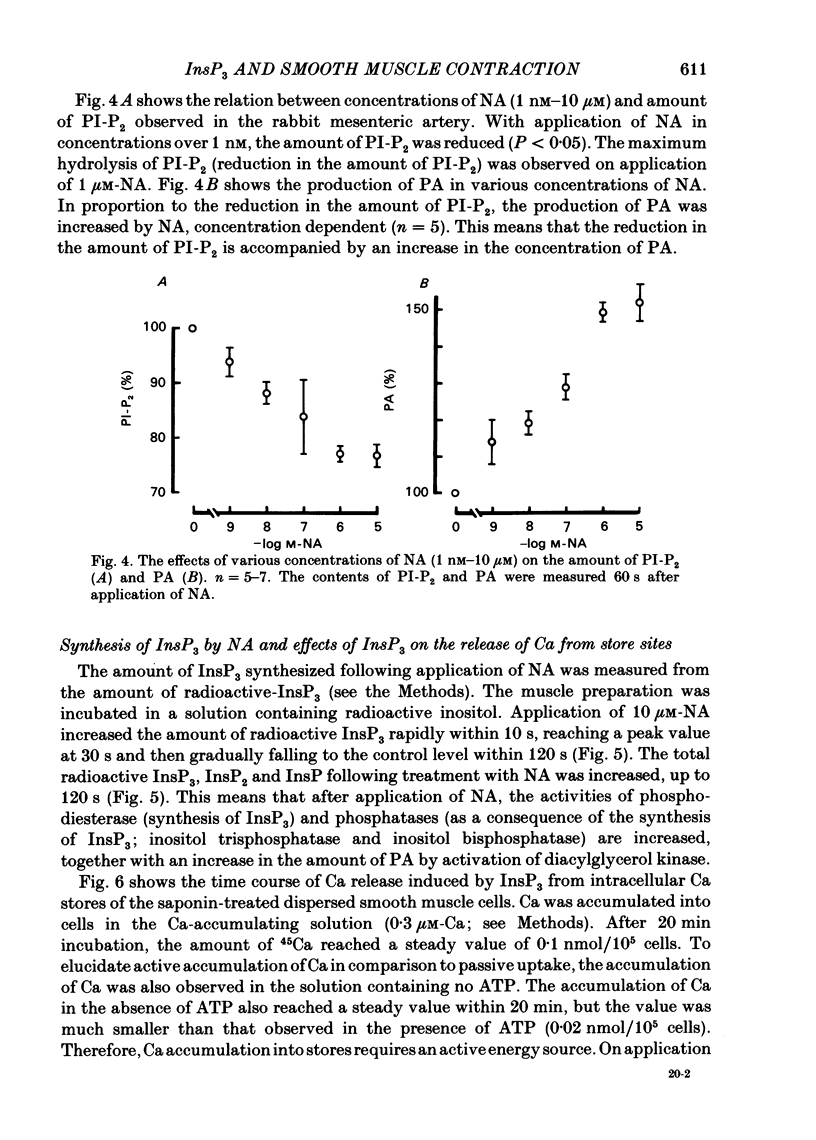

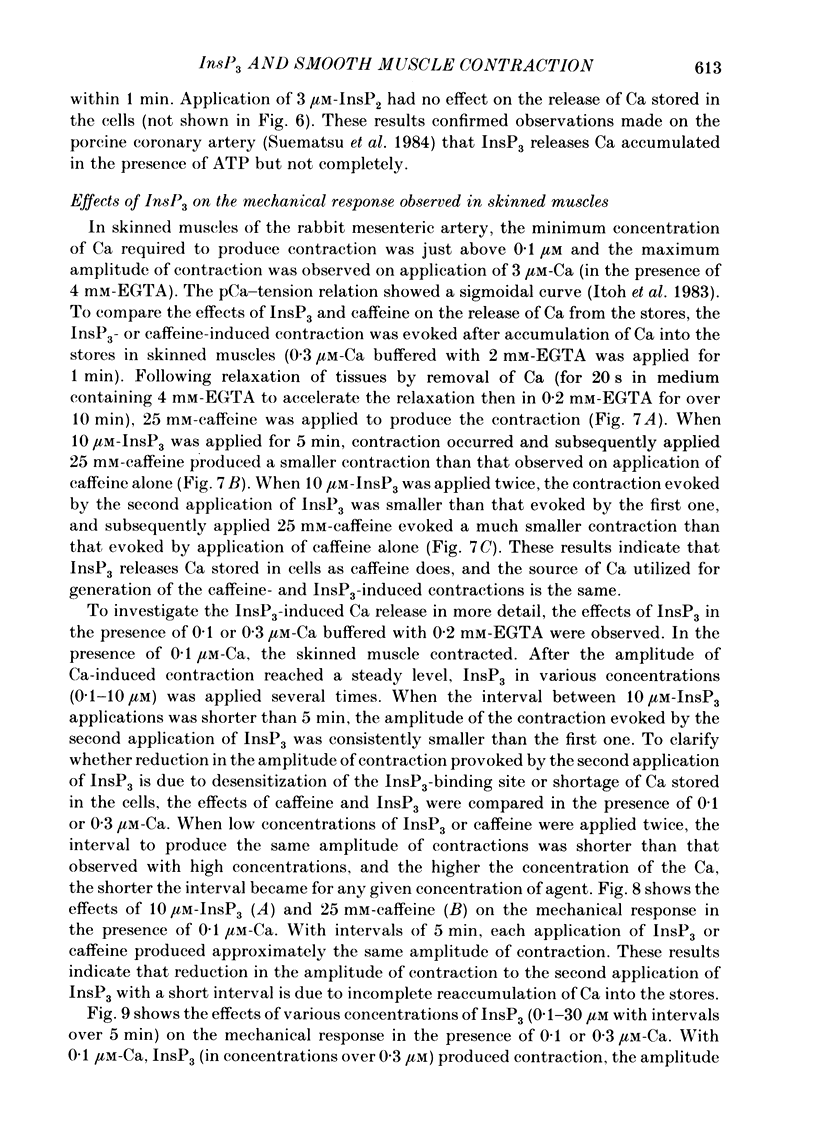




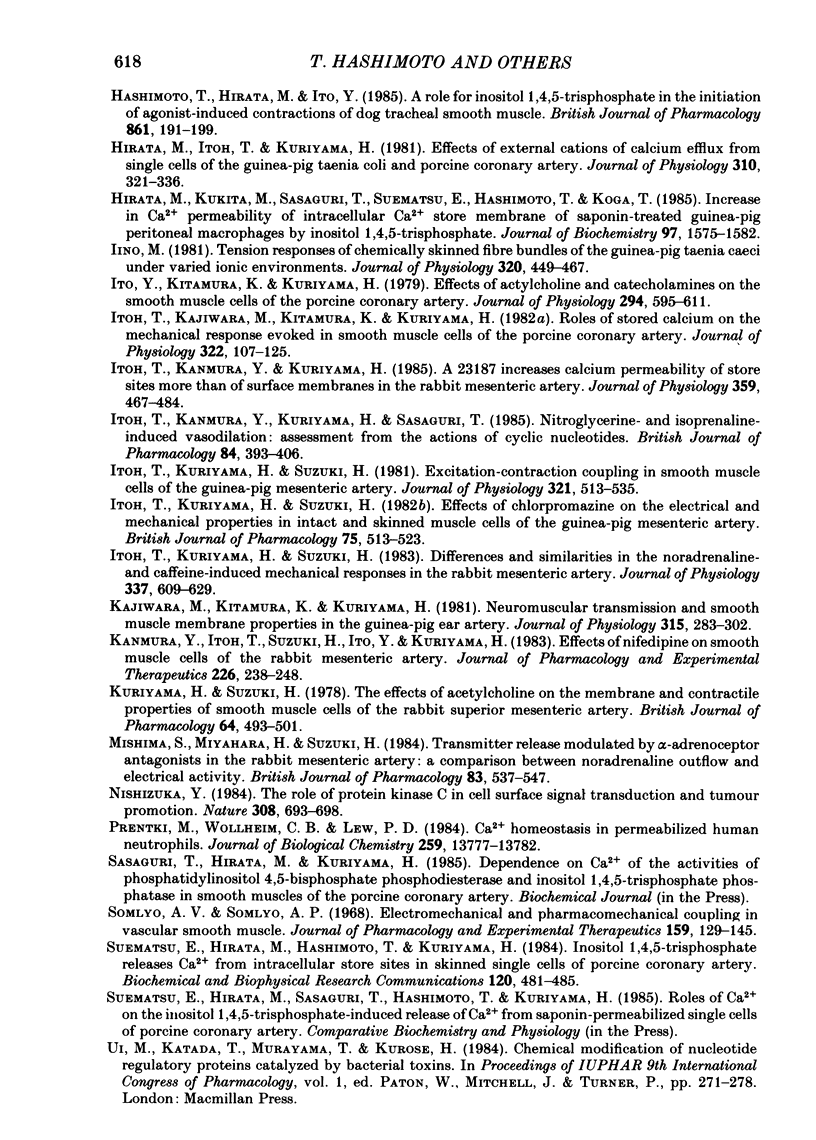
Selected References
These references are in PubMed. This may not be the complete list of references from this article.
- BULBRING E. Correlation between membrane potential, spike discharge and tension in smooth muscle. J Physiol. 1955 Apr 28;128(1):200–221. doi: 10.1113/jphysiol.1955.sp005299. [DOI] [PMC free article] [PubMed] [Google Scholar]
- Berridge M. J. Inositol trisphosphate and diacylglycerol as second messengers. Biochem J. 1984 Jun 1;220(2):345–360. doi: 10.1042/bj2200345. [DOI] [PMC free article] [PubMed] [Google Scholar]
- Berridge M. J., Irvine R. F. Inositol trisphosphate, a novel second messenger in cellular signal transduction. Nature. 1984 Nov 22;312(5992):315–321. doi: 10.1038/312315a0. [DOI] [PubMed] [Google Scholar]
- Berridge M. J. Rapid accumulation of inositol trisphosphate reveals that agonists hydrolyse polyphosphoinositides instead of phosphatidylinositol. Biochem J. 1983 Jun 15;212(3):849–858. doi: 10.1042/bj2120849. [DOI] [PMC free article] [PubMed] [Google Scholar]
- Billah M. M., Lapetina E. G. Rapid decrease of phosphatidylinositol 4,5-bisphosphate in thrombin-stimulated platelets. J Biol Chem. 1982 Nov 10;257(21):12705–12708. [PubMed] [Google Scholar]
- Bolton T. B. Mechanisms of action of transmitters and other substances on smooth muscle. Physiol Rev. 1979 Jul;59(3):606–718. doi: 10.1152/physrev.1979.59.3.606. [DOI] [PubMed] [Google Scholar]
- Downes C. P., Mussat M. C., Michell R. H. The inositol trisphosphate phosphomonoesterase of the human erythrocyte membrane. Biochem J. 1982 Apr 1;203(1):169–177. doi: 10.1042/bj2030169. [DOI] [PMC free article] [PubMed] [Google Scholar]
- Endo M. Calcium release from the sarcoplasmic reticulum. Physiol Rev. 1977 Jan;57(1):71–108. doi: 10.1152/physrev.1977.57.1.71. [DOI] [PubMed] [Google Scholar]
- Fabiato A., Fabiato F. Calcium release from the sarcoplasmic reticulum. Circ Res. 1977 Feb;40(2):119–129. doi: 10.1161/01.res.40.2.119. [DOI] [PubMed] [Google Scholar]
- Hashimoto T., Hirata M., Ito Y. A role for inositol 1,4,5-trisphosphate in the initiation of agonist-induced contractions of dog tracheal smooth muscle. Br J Pharmacol. 1985 Sep;86(1):191–199. doi: 10.1111/j.1476-5381.1985.tb09449.x. [DOI] [PMC free article] [PubMed] [Google Scholar]
- Hirata M., Itoh T., Kuriyama H. Effects of external cations on calcium efflux from single cells of the guinea-pig taenia coli and porcine coronary artery. J Physiol. 1981 Jan;310:321–336. doi: 10.1113/jphysiol.1981.sp013552. [DOI] [PMC free article] [PubMed] [Google Scholar]
- Hirata M., Kukita M., Sasaguri T., Suematsu E., Hashimoto T., Koga T. Increase in Ca2+ permeability of intracellular Ca2+ store membrane of saponin-treated guinea pig peritoneal macrophages by inositol 1,4,5-trisphosphate. J Biochem. 1985 Jun;97(6):1575–1582. doi: 10.1093/oxfordjournals.jbchem.a135214. [DOI] [PubMed] [Google Scholar]
- Iino M. Tension responses of chemically skinned fibre bundles of the guinea-pig taenia caeci under varied ionic environments. J Physiol. 1981 Nov;320:449–467. doi: 10.1113/jphysiol.1981.sp013961. [DOI] [PMC free article] [PubMed] [Google Scholar]
- Ito Y., Kitamura K., Kuriyama H. Effects of acetylcholine and catecholamines on the smooth muscle cell of the porcine coronary artery. J Physiol. 1979 Sep;294:595–611. doi: 10.1113/jphysiol.1979.sp012948. [DOI] [PMC free article] [PubMed] [Google Scholar]
- Itoh T., Kajiwara M., Kitamura K., Kuriyama H. Roles of stored calcium on the mechanical response evoked in smooth muscle cells of the porcine coronary artery. J Physiol. 1982 Jan;322:107–125. doi: 10.1113/jphysiol.1982.sp014026. [DOI] [PMC free article] [PubMed] [Google Scholar]
- Itoh T., Kanmura Y., Kuriyama H. A23187 increases calcium permeability of store sites more than of surface membranes in the rabbit mesenteric artery. J Physiol. 1985 Feb;359:467–484. doi: 10.1113/jphysiol.1985.sp015597. [DOI] [PMC free article] [PubMed] [Google Scholar]
- Itoh T., Kanmura Y., Kuriyama H., Sasaguri T. Nitroglycerine- and isoprenaline-induced vasodilatation: assessment from the actions of cyclic nucleotides. Br J Pharmacol. 1985 Feb;84(2):393–406. doi: 10.1111/j.1476-5381.1985.tb12923.x. [DOI] [PMC free article] [PubMed] [Google Scholar]
- Itoh T., Kuriyama H., Suzuki H. Differences and similarities in the noradrenaline- and caffeine-induced mechanical responses in the rabbit mesenteric artery. J Physiol. 1983 Apr;337:609–629. doi: 10.1113/jphysiol.1983.sp014645. [DOI] [PMC free article] [PubMed] [Google Scholar]
- Itoh T., Kuriyama H., Suzuki H. Effects of chlorpromazine on the electrical and mechanical properties of intact and skinned muscle cells of guinea-pig mesenteric artery. Br J Pharmacol. 1982 Mar;75(3):513–523. doi: 10.1111/j.1476-5381.1982.tb09168.x. [DOI] [PMC free article] [PubMed] [Google Scholar]
- Itoh T., Kuriyama H., Suzuki H. Excitation--contraction coupling in smooth muscle cells of the guinea-pig mesenteric artery. J Physiol. 1981 Dec;321:513–535. doi: 10.1113/jphysiol.1981.sp014000. [DOI] [PMC free article] [PubMed] [Google Scholar]
- Kajiwara M., Kitamura K., Kuriyama H. Neuromuscular transmission and smooth muscle membrane properties in the guinea-pig ear artery. J Physiol. 1981 Jun;315:283–302. doi: 10.1113/jphysiol.1981.sp013748. [DOI] [PMC free article] [PubMed] [Google Scholar]
- Kanmura Y., Itoh T., Suzuki H., Ito Y., Kuriyama H. Effects of nifedipine on smooth muscle cells of the rabbit mesenteric artery. J Pharmacol Exp Ther. 1983 Jul;226(1):238–248. [PubMed] [Google Scholar]
- Kuriyama H., Suzuki H. The effects of acetylcholine on the membrane and contractile properties of smooth muscle cells of the rabbit superior mesenteric artery. Br J Pharmacol. 1978 Dec;64(4):493–501. doi: 10.1111/j.1476-5381.1978.tb17310.x. [DOI] [PMC free article] [PubMed] [Google Scholar]
- Mishima S., Miyahara H., Suzuki H. Transmitter release modulated by alpha-adrenoceptor antagonists in the rabbit mesenteric artery: a comparison between noradrenaline outflow and electrical activity. Br J Pharmacol. 1984 Oct;83(2):537–547. doi: 10.1111/j.1476-5381.1984.tb16518.x. [DOI] [PMC free article] [PubMed] [Google Scholar]
- Nishizuka Y. The role of protein kinase C in cell surface signal transduction and tumour promotion. Nature. 1984 Apr 19;308(5961):693–698. doi: 10.1038/308693a0. [DOI] [PubMed] [Google Scholar]
- Prentki M., Wollheim C. B., Lew P. D. Ca2+ homeostasis in permeabilized human neutrophils. Characterization of Ca2+-sequestering pools and the action of inositol 1,4,5-triphosphate. J Biol Chem. 1984 Nov 25;259(22):13777–13782. [PubMed] [Google Scholar]
- Somlyo A. V., Somlyo A. P. Electromechanical and pharmacomechanical coupling in vascular smooth muscle. J Pharmacol Exp Ther. 1968 Jan;159(1):129–145. [PubMed] [Google Scholar]
- Suematsu E., Hirata M., Hashimoto T., Kuriyama H. Inositol 1,4,5-trisphosphate releases Ca2+ from intracellular store sites in skinned single cells of porcine coronary artery. Biochem Biophys Res Commun. 1984 Apr 30;120(2):481–485. doi: 10.1016/0006-291x(84)91279-8. [DOI] [PubMed] [Google Scholar]


